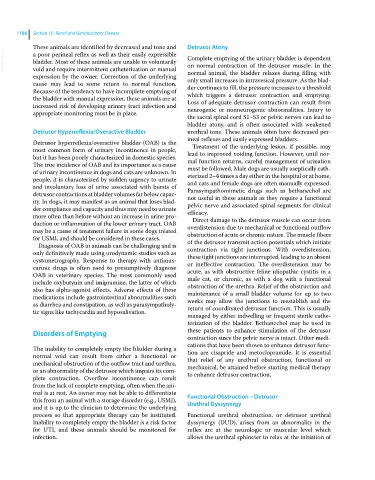Page 1248 - Clinical Small Animal Internal Medicine
P. 1248
1186 Section 10 Renal and Genitourinary Disease
These animals are identified by decreased anal tone and Detrusor Atony
VetBooks.ir a poor perineal reflex as well as their easily expressible Complete emptying of the urinary bladder is dependent
bladder. Most of these animals are unable to voluntarily
on normal contraction of the detrusor muscle. In the
void and require intermittent catheterization or manual
expression by the owner. Correction of the underlying normal animal, the bladder relaxes during filling with
only small increases in intravesical pressure. As the blad
cause may lead to some return to normal function. der continues to fill, the pressure increases to a threshold
Because of the tendency to have incomplete emptying of which triggers a detrusor contraction and emptying.
the bladder with manual expression, these animals are at Loss of adequate detrusor contraction can result from
increased risk of developing urinary tract infection and neurogenic or nonneurogenic abnormalities. Injury to
appropriate monitoring must be in place.
the sacral spinal cord S1–S3 or pelvic nerves can lead to
bladder atony, and is often associated with weakened
Detrusor Hyperreflexia/Overactive Bladder urethral tone. These animals often have decreased per
ineal reflexes and easily expressed bladders.
Detrusor hyperreflexia/overactive bladder (OAB) is the Treatment of the underlying lesion, if possible, may
most common form of urinary incontinence in people, lead to improved voiding function. However, until nor
but it has been poorly characterized in domestic species. mal function returns, careful management of urination
The true incidence of OAB and its importance as a cause must be followed. Male dogs are usually aseptically cath
of urinary incontinence in dogs and cats are unknown. In eterized 2–4 times a day either in the hospital or at home,
people, it is characterized by sudden urgency to urinate and cats and female dogs are often manually expressed.
and involuntary loss of urine associated with bursts of Parasympathomimetic drugs such as bethanechol are
detrusor contractions at bladder volumes far below capac not useful in these animals as they require a functional
ity. In dogs, it may manifest as an animal that loses blad pelvic nerve and associated spinal segments for clinical
der compliance and capacity and thus may need to urinate efficacy.
more often than before without an increase in urine pro Direct damage to the detrusor muscle can occur from
duction or inflammation of the lower urinary tract. OAB overdistension due to mechanical or functional outflow
may be a cause of treatment failure in some dogs treated obstruction of acute or chronic nature. The muscle fibers
for USMI, and should be considered in these cases. of the detrusor transmit action potentials which initiate
Diagnosis of OAB in animals can be challenging and is
only definitively made using urodynamic studies such as contraction via tight junctions. With overdistension,
these tight junctions are interrupted, leading to an absent
cystometrography. Response to therapy with antimus or ineffective contraction. The overdistension may be
carinic drugs is often used to presumptively diagnose acute, as with obstructive feline idiopathic cystitis in a
OAB in veterinary species. The most commonly used male cat, or chronic, as with a dog with a functional
include oxybutynin and imipramine, the latter of which obstruction of the urethra. Relief of the obstruction and
also has alpha‐agonist effects. Adverse effects of these maintenance of a small bladder volume for up to two
medications include gastrointestinal abnormalities such weeks may allow the junctions to reestablish and the
as diarrhea and constipation, as well as parasympatholy return of coordinated detrusor function. This is usually
tic signs like tachycardia and hyposalivation.
managed by either indwelling or frequent sterile cathe
terization of the bladder. Bethanechol may be used in
Disorders of Emptying these patients to enhance stimulation of the detrusor
contraction since the pelvic nerve is intact. Other medi
cations that have been shown to enhance detrusor func
The inability to completely empty the bladder during a tion are cisapride and metoclopramide. It is essential
normal void can result from either a functional or that relief of any urethral obstruction, functional or
mechanical obstruction of the outflow tract and urethra, mechanical, be attained before starting medical therapy
or an abnormality of the detrusor which impairs its com to enhance detrusor contraction.
plete contraction. Overflow incontinence can result
from the lack of complete emptying, often when the ani
mal is at rest. An owner may not be able to differentiate Functional Obstruction – Detrusor
this from an animal with a storage disorder (e.g., USMI), Urethral Dyssynergy
and it is up to the clinician to determine the underlying
process so that appropriate therapy can be instituted. Functional urethral obstruction, or detrusor urethral
Inability to completely empty the bladder is a risk factor dyssynergy (DUD), arises from an abnormality in the
for UTI, and these animals should be monitored for reflex arc at the neurologic or muscular level which
infection. allows the urethral sphincter to relax at the initiation of

